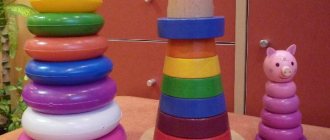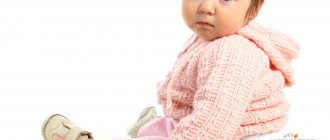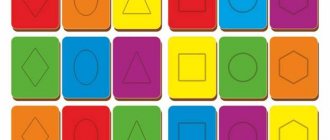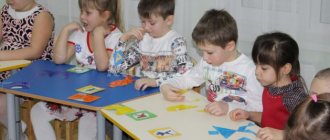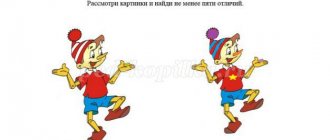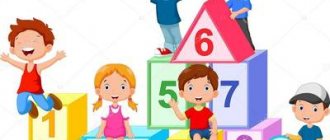The purpose of the didactic game “Figures”
The card index lists games with many didactic functions that ensure the comprehensive development of the child. But their common goal is to form an idea of geometric shapes.
General tasks:
- memorization and comprehension of geometric figures;
- consolidation of ideas about colors and outlines of surrounding objects;
- development of visual, including color, spatial and planar perception;
- improving the skills of comparative analysis, classification, generalization;
- memory training, concentration, intelligence, and the ability to think logically;
- formation of the skill of ordinal counting, primary mathematical knowledge;
- improvement of finger motor skills, general physical development;
- expansion of individual vocabulary, development of the skill of detailed answers to questions;
- nurturing perseverance, determination, independence, observation, the ability to act according to rules and instructions, and work productively in a team.
Middle group
We offer didactic games for children “Geometric Shapes”, which can be used in the middle age group, that is, for pupils 4-5 years old.
Wonderful bag
Take a medium-sized bag of opaque material for the game, pick up several medium-sized objects that have a clearly defined geometric shape: a ball, a ball of thread, an apple, a box of pencils, a cube, a box of matches, etc. Put everything in a bag, ask your child to draw out only round-shaped objects, then only rectangular ones.
Geometric football
The game introduces preschoolers to two spatial objects: a ball and a cube. Build something like a football goal on the table. Ask your child to roll first the ball into the goal, then the cube. Then help the student draw conclusions: the ball has no corners, so it rolls easily; the cube is more difficult to move due to the presence of edges, but it is more stable on a horizontal surface.
House for a hedgehog
To play, cut out triangles of different sizes: take two paper squares - one larger, the other smaller, and cut them diagonally. Lay out the resulting figures in front of the student, tell them that autumn has come, the hedgehog is getting ready to fall asleep until spring, you need to help him build a cozy house from all the triangles presented.
Fish
Cut triangles from square sheets using the method described above. Ask your preschooler to make a fish out of the shapes. This can be done in several ways, the main thing is that the triangles should not intersect. If the child likes some version of the geometric fish more than others, you can make an applique out of it using glue.
Relay race
Divide the students into two teams. Each group of children stands in a row. Place a stool at the beginning of each row. At the other end of the room, place cardboard squares and triangles mixed together on the table.
When the start sounds, the players take turns running up to the table, grabbing the piece, and carrying it to their stool. The first team must collect squares, the second - triangles. The game ends when all players in one of the teams have participated in the relay. This team wins, but only if the pieces are assembled correctly.
Say it in one word
For the game, prepare groups of geometric shapes, united by shape, but with different other characteristics. For example, large and small rectangles, circles of different colors. Place objects on the table in groups of 4. The child must name them with a general word.
Arrange by size
For the game, make paired geometric shapes: one object in the pair is large, the second is small. Place two squares on the table. The student’s task is to place other objects on the squares according to their size. That is, you need to put large triangles, ovals, etc. on a large square, and equally small ones on a small one.
Didactic game “Find the figures”
For a board game, make paired cards depicting several geometric shapes. Take some pictures from the pairs and place the others on the table. Show the children the cards one by one, and they must find similar images on the table.
Find a house
For an active game, give the children a small geometric image: one is a circle, another is a square, another is a triangle, and so on. Place stools with corresponding shapes in different places in the playroom. Turn on music to which children should run around the room and dance. When the music stops, children must quickly find their “house,” that is, a stool, and run up to it. The game can be complicated: move the stools away so that the players do not notice it.
Didactic game “Shapes and Forms”
To play, print out geometric pictures. Show your child the shapes at random, and he must name the object of the corresponding shape. For example, having seen a circle, a student can name the following objects: apple, ball, orange, wheel, sun.
What's hidden
Place geometric images in front of the student. Let the preschooler look at them carefully, then close his eyes and not peek. Hide one of the pictures. The student, having opened his eyes, must remember which figure disappeared.
Card index of didactic games “Shape, size, color”
Let's study the figures:
1. "Domino"
Task: to teach children to find a specific figure among many in order to name it, to consolidate their knowledge of geometric shapes
Equipment: 28 cards, each half of which depicts one or another geometric figure (circle, square, triangle, rectangle, oval, polygon). "Double" cards depict two identical figures, the seventh "double" consists of two empty halves.
The cards are laid out on the table, numbers down. After explaining the rules to the child, the game begins by placing a "double blank" card. As in ordinary dominoes, in one move the child takes and places the desired card at both ends of the “track” and names the figure. If the player does not have the required figure on the card, look for an image with this figure from the total number of cards. If the child does not name the piece, he does not have the right to the next move. The one who gets rid of the cards before the rest wins.
2. “Solve the confusion” Task: to teach children to freely use topics for their intended purpose.
Equipment: toys of different designs that can be grouped (dolls, animals, cars, pyramids, balls, etc.).
All toys are placed on the table in a certain order. The child leaves and the leader changes the position of the toys. The child must notice the confusion, remember how it was before, and restore the previous order.
First, for example, change the blue cube to a red one. So make the task more difficult: put the doll to sleep under the bed, cover the ball with a blanket. Having tried the taste, the child can confuse himself, inventing the most incredible situations.
3. “Help Fedora”
Objective: to develop children’s understanding of color, to teach them to correlate the colors of dissimilar objects.
Equipment: postcards with pictures of cups and handles of different colors.
“Guys, in poor grandmother Fedora’s house all the cups are broken. Their handles are broken, and now he won’t be able to drink his favorite tea with raspberry jam from them. Let's help Grandma Fedora glue the cups. But to do this, you have to look closely at those cup cards and find the pens that match them in color.” If your child has difficulty completing this task, show him how to look for matching cards. The task is then carried out in this way.
4. “Find objects of similar color”
Objective: teach the child to compare objects by color and generalize them by color.
Equipment:: various vehicles, toys of five shades of each color (cup, saucer, threads; doll clothes: dress, shoes, skirt; toys: flag, bear, ball, etc.).
The toys are placed on two tables next to each other. The child is given an object or toy. He must independently select all the shades of this color to the color of his toy, compare them and try to name the color.
5. “Find an object of the same shape”
Task: to teach the child to distinguish certain objects from the environment by shape, using geometric patterns.
Equipment: geometric shapes (circle, square, oval, triangle, rectangle), round-shaped objects (balls, balls, buttons), square (cubes, scarf, cards), triangular (building material, flag, book), oval-shaped ( egg, cucumber).
Separate geometric shapes and objects into two piles. The child is encouraged to examine objects carefully. Then we show the child a picture (it's okay if the child names it) and ask him to find an object of the same shape. If you make a mistake, ask your child to first trace the figure with his finger, and then the object.
6. "Magic Circles"
Task: teach the child to identify certain objects by shape.
Equipment: a sheet of paper with circles of the same size drawn on it (ten circles in total).
“Let's take a closer look at this leaf. What do you see there? What shape do you draw on a piece of paper? Now close your eyes and imagine a circle.”
Next, the child is asked to draw an object from a circle drawn on paper. Ask one child from each circle to draw something based on the circle.
7. “Arrange the ornament”
Task: to teach the child to identify the spatial arrangement of geometric shapes, and to reproduce exactly the same arrangement when arranging the ornament.
Equipment: 5 geometric shapes cut out of colored paper, 5 pieces each (25 pieces in total), crafts.
“Look at the decorations in front of him. Think and name the numbers you see here. Now try to design the same pattern with cut out geometric shapes.”
Then the next card is offered. The task remains the same. The game ends when the child places all the decorations shown on the card.
8. "Game of circles"
Task: to teach children to denote in words the relationships between objects by size (“more”, “smaller”, “greater”).
Equipment: three circles (drawn and cut out on paper) of different sizes.
It is suggested that you look carefully at the circles, place them in front of you, and trace them on paper along the contour. Then the child is asked to compare 2 circles, and then 2 more circles. Ask your child to name the size of all three circles.
9. "Balls"
Objective: to develop and consolidate the ability to establish relationships between dimensional elements (larger - smaller, thicker, longer, shorter).
Equipment: a series of five sticks that decrease evenly in length and width, a series of five circles that also decrease evenly depending on the sticks.
“Let's see what happened. On the street, kind grandfather Fedot was selling balls. How beautiful they are! Everyone liked it. But suddenly, out of nowhere, such a strong wind rose that all of Ded Fedot’s eggs broke off the sticks and scattered in all directions. For a whole week, kind neighbors brought the found balls. But here's the problem! Grandfather Fedot cannot understand which club was attached to which ball. Let's help him! "
First, together with the child, the sticks are laid out on the table according to size from the longest and thickest to the shortest and thinnest. Then, using the same method, the "balls" are arranged from largest to smallest.
What else to read: Intellectual and educational game “Space Travel”
Next, sticks and circles are compared. You can mix all the shapes and ask the child to independently determine the ratio of the elements in size and length.
10. “Help Santa Claus”
Task: to teach the child to use an intermediate means - a measure - to determine the height of objects.
Equipment: a series of five strips, the length of which systematically changes, four pyramids, the height of which also decreases.
“Santa Claus came to the children for the holiday and brought them toys: pyramids as a gift. They are all different sizes: the smallest pyramid is for the youngest, and the largest for the oldest. Find just such a pyramid (one of the stripes is shown).”
After finding all the pyramids, ask your child to point to the largest pyramid, then the smallest. Then have your child repair the “pyramids” as they get smaller. Then have him test himself using measuring strips.
11. "Smart Host"
Objective: to develop the ability to study the shape of objects, give and understand their complex description.
Equipment: plastic children's dishes, bag.
The toys are inspected by the participants and then placed in a bag. The child sits with his back to the players. They take turns coming up to him, patting him on the shoulder and saying: “Anya needs something like that, but I won’t say her name, but I’ll explain what it is... an object, for example a cup: “round, with convex sides, low , narrow at the bottom, wide at the top, handle on the side").
When the child finds the desired item by touch, he takes it out of the bag; it then evaluates whether the task was completed successfully.
12. "Merry Man"
Task: to develop in children the ability to dissect a certain figure into elements (geometric figures) and, conversely, to create objects of a certain shape from individual elements corresponding to geometric patterns.
Equipment: geometric shapes (1 triangle, 1 semicircle, 1 rectangle, 2 ovals, 4 narrow rectangles, image of a “Jolly Man”).
“Today a cheerful man came to us. Look how funny it is! Let’s try to make geometric shapes that represent the same person on the table.”
13. "Sticks"
Task:
Teach children the sequential arrangement of elements of different sizes.
Equipment:
10 sticks (wooden or cardboard) of different lengths (from 2 to 20 cm). Each subsequent stick differs from the previous one by 2 cm in size. To complete this task correctly, each time you need to take the longest strip of those that you see in front of you. Let's use this rule and arrange the sticks in a row. But if you make even one mistake, whether it's rearranging pieces or testing clubs, it's game over.
14. "Find a Home"
Task: to form a visual perception of the form.
Equipment: two series of geometric figures, six figures each. Three of these figures (square, circle, triangle) are basic, and the other three (trapezoid, oval, rhombus) are additional. Additional digits are necessary to correctly distinguish and select the main digits. It is also necessary to outline images of each figure on separate cards (you can cut out the outlines and make “windows”). Each stimulus set contains six to eight cards with an outline of each shape. Cards can be painted in different colors.
Children are shown three basic shapes (circle, square, triangle). Then a card with one shape (for example, a triangle) is shown. “What do you guys think, what kind of figure lives in this house? Let's think together and “put” the required amount here. Now, guys, let's play together. You see, there are different figures on the two tables (they are called two children). Here are the cards. What figures live in these houses? “After completing the task, two more identical cards are dealt. If the child finds it difficult to complete the task, he is asked to trace the “frame” of the shape with his finger, and then draw a few contour figures in the air, which will make it easier to reproduce the shape.
15. “Show me the same”
Task: teach a child to build an image of an object of a certain size.
Equipment: geometric shapes (square, circle, triangle, oval, hexagon) of different sizes. The serial number of geometric shapes depends on the number of children. The set requires 3-4 variations of each figure. “I have the same numbers. I show you a figurine and you need to find the same thing in your set. Be very careful!
After the children have found and shown a figure, the presenter “tests” their choice on his figure. If the child is convinced of the mistake, he is allowed to correct it himself by replacing the selected number with another.
16. “What did the doll bring us?”
Task: to teach the child to feel the shape of an object and name it.
Equipment: doll, bag, all kinds of small toys, which should be noticeably different from each other and depict objects familiar to children (cars, cubes, toy plates, animal toys, balls, etc.). It is recommended to put a rubber band in the bag so that the child cannot look at it when looking for a toy.
"Guys! The doll Masha came to us today. She brought us toys. Do you want to know what the doll brought us? Hands, then say what you have chosen, and only then take it out of the bag and show everything.”
After all the toys are taken out of the bag, the game is repeated again. All the toys are returned and the children take turns taking out their toys.
17. "Good balls"
Task: to develop an idea of shape and color.
Equipment: drawing balls (10-12 pieces) oval and round, flag.
“Look at the drawing. How many balls! Color the round balls blue and the oval balls red. Draw ties for the balls so that they do not fly away in the wind and do not “fit the flag.”
18. "Find the shapes"
Task: to develop visual perception of geometric shapes.
What else to read: Didactic games for children 3-4 years old
Equipment: drawings of geometric shapes. “Look at these photos. Find geometric shapes. The winner is the one who finds more pieces and, most importantly, faster.
19. “Where is it?”
Task: to form spatial orientation on a sheet of paper.
Equipment: a white sheet of paper on which geometric shapes (oval, square, rectangle, triangle) of different colors are depicted; it is possible to replace geometric shapes with various images of animals (bear, fox, hare, cow), vehicles (ship), airplane, cars, Kamaz), toys and other figures are located in the corners, with a circle drawn in the middle.
“Look carefully at the drawing and tell me where the circle is drawn? Oval? Square? Triangle? Rectangle?
Show me what is drawn to the right of the circle?, To the left of the circle?
What is shown in the upper right corner?, in the lower left corner?
What is drawn above the circle?, Below the circle?
Senior group
We recommend these games on geometry for preschoolers in the older age group, that is, 5-6 years old.
Mosaic
For the game, prepare cards depicting objects made of geometric shapes. Invite the student to look carefully at the image, say what shapes he sees, whether they are large, whether there are many of them. Next, lay out the corresponding figures in front of the child and ask them to make an image similar to the one on the card.
When the preschooler begins to deftly complete the task, you can offer a complication: let him make an image without looking at the card. You can also invite the student to dream up: make another image from the same figures.
Pizza
To play, make a large circle - this will be the base of the pizza. Divide it into parts according to the number of children participating. Also cut out a lot of small shapes - this will be the filling for the pizza.
One child creates a geometric pattern on one of the pizza slices. The rest of the players must make the same pattern on their pieces. When the children have completed it, ask them what kind of figures they used and in what quantity.
If one child is playing, then name him the geometric objects that he should lay out as “filling”.
Fashionable glasses
For the game, prepare images of glasses with lenses of different geometric shapes. There should be holes instead of glass. Separately, cut out geometric shapes corresponding to the holes. The child’s task is to find suitable glasses for each glasses.
When the first task is completed, ask the student to find objects in the room and outside the window that are as close in shape as possible to the lenses of the glasses.
If two children are playing, encourage them to choose glasses with different lenses. Each player tries to find an object around that consists of two geometric shapes at once: like his own glasses and his friend’s glasses.
Ladybug wings
For the game, make images of ladybugs. They should have one wing, cut the second one separately. On the wings of insects, instead of black dots, different geometric shapes should be depicted; each ladybug has its own.
Lay out the blanks in front of the players, tell them that the bugs are playing too much and have lost their beautiful wings. We need to help them find them. Children find a suitable wing for each insect. Next, they count how many figured dots the bugs have on each wing and on both.
Find the extra figure
For the game, prepare cards, each of which depicts 4 geometric shapes. The game task is to find an object that does not correspond to the other three in most respects, and comment on the choice. For example, there is a small red circle, a large red circle, a small green circle, and a large yellow square. It is clear that the extra one is the last figure, since it does not correspond to the others in two of the three characteristics: shape and color.
Geometric competition
Make a playing field out of whatman paper: draw different figures on it. Two children are playing: they take turns throwing a die. For hitting a triangle, 1 point is given, for a square - 2 points, for a circle - 3 points, for a rectangle - 4 points. Before the game, you should agree on how many moves there will be. The player with the most points wins.
Collect the figures
For a board game, prepare images of figures lined up in a row. Moreover, objects should not be located chaotically, but in a certain order according to the principle of alternation. The task of the player who received the image is to continue the row and correctly select the next pieces in order. After completing the task, the player names the geometric objects that he used.
The game can be organized as a competitive one. Children play in pairs, the winner is the one who completes their row first. Further, it is possible to complicate the task: remove 2-3 objects from the row laid out by one player, and the second student must insert the correct figures into the empty areas.
Choose your figure
Prepare for the game large and small images of daisies with geometric shapes in the center. Place large flowers on the table. Let the children list the shapes they see. Ask the students to match each large daisy with a small one with a similar core.
Figured domino
For the game, make 28 pictures. Half of each of them should depict a certain geometric figure. Duplicate cards must have identical objects drawn on them. And the seventh duplicated picture must have both empty halves.
Place the cards on the table with the backs facing up. The game rules correspond to regular dominoes; the game starts with an empty duplicate card. The move is to lay out the card to the edge of the chain so that the same images are joined. If the player does not have a corresponding picture, then he takes the one he needs from the general pile. The first player to get rid of his cards wins.
Matryoshka dolls
For the game, prepare images of nesting dolls with geometric contours that form a pattern on the sundress. Separately cut out the shapes corresponding to the elements of the pattern.
Look at each geometric object with your children, let the children trace it with their finger and say what it is called. Next, invite the students to return the elegant look to the nesting doll sundresses. Children select shapes from a pile and place them on the contours of the sundress patterns.
A chest of useful things (we study colors and shapes)
Not only do you learn colors with your child, but you also develop fine motor skills through counting. Hammers - and color, fine motor skills and coordination of movements, counting, you can play “find a couple”.
Mushrooms on a stand.
Mushrooms are sorted by color (5 colors), by size (3 sizes), and by the pattern on the caps. So, we count, remember the colors, distinguish more or less equal ones, order, insert a stick. Rod cylinders. We study colors, develop fine motor skills, count to 25, and study the concepts of “big-small-medium”.
"What is color?"
This manual will introduce your child to colors such as red, blue, green, yellow, orange. The images are bright, without unnecessary details, one-color and 4 two-color images. There is a main page where advice is given on working with the book, and various games are offered to develop a child’s color perception. All paintings are cut out and laminated (sealed with tape). At first I just laid out a few images in front of my daughter, naming the colors and telling them what color there was, and after a year they were completely engaged in them, choosing all the images of red, etc., arranged in piles of color. The book includes a cardboard insert - a game: a large multi-colored flower on a white background (primary colors) and 8 colored squares depicting a flower and a butterfly, which can be placed on a petal of the same color.
"Square and Circle"
Thanks to the book, the child learns geometric shapes (circle, square, oval, triangle), colors, and also learns to apply them in the right place on the image. I made this instruction reusable and glued the pages and figures together with tape. For the figures, we glued them to the back of the squares with double-sided tape and received a manual with reusable stickers. The main page provides examples of educational game actions with cubes, pyramids, etc. Recommendations are given on what toys to buy for a child in order to develop the perception of color, size and shape.
"Shape, color."
Thanks to the characters in the fairy tale “Ryaba Hen” (the book contains this particular fairy tale from beginning to end), the child will know the geometric shapes (triangle, square, oval, semi-oval) that must be attached to the corresponding element in the photo. We did not consider this book as a work of fiction; we read fairy tales in a worthy collection. The purpose of this manual is to study geometric shapes, colors, and develop logical thinking.
"Color, shape." This manual will introduce your child to geometric shapes (triangle, circle, square), and you will also be able to repeat the colors and concepts of big and small. My daughter loves to complement images with missing geometric shapes.
The cardboard inlay contains a geometric lot with game options presented on the main page:
| 1 | Find all the triangles (squares, ovals, circles) between the shapes). |
| 2 | Show the largest triangle (square, oval, circle). |
| 3 | Show the smallest triangle (etc.). |
| 4 | Arrange the shapes in descending order: place the largest circle first, then the smallest, then the smallest. |
| 5 | Find all the red shapes (blue, yellow. |
| 6 | Build a yellow house with a red roof from the figures. |
| 7 | Build a pyramid of circles (etc.). |
Well, stick it on yourself, how would you do without it)))
"Complete the mosaic."
Learning about color and shape and developing fine motor skills.
"Animals. Geometric figures".
"Color images".
We guess from the silhouette what is depicted, look for the desired sticker and play with color.
GAMES WITH GEOMETRIC SHAPES.
It is important to teach your child to perceive and distinguish the shapes of objects and remember their names. To do this, the child studies the shape of an object with his hands and eyes and applies the acquired knowledge to solve a specific problem (for example, to select suitable geometric shapes for a slot of the appropriate shape). As a result of purposeful games, the child remembers the standards of geometric shapes and their names. Round is not round. Place round shaped objects in a tight bag (wheel, plastic plate, pyramid rings, teething ring, etc.) and other objects (matryoshka doll, cube, book, bar of soap, etc.). The child needs to get only round objects without looking. Or take any object and say whether it is round or not. “Recognize the figure” Prepare paired volumetric geometric figures: cube, ball, parallelepiped, cylinder, cone, etc. One set of figures is folded into a bag, the second is placed on the table. Show any figurine on the table and ask the child to take it out of the bag. Name the resulting figure: “parallelepiped”, “cylinder”.
“What is blue”
The board game “Gnomes and Houses” will introduce your child to flowers. Contains 7 large and 42 small lotteries with colorful images. And instructions, where there are 5 game options (1. Twin gnomes. 2. Collect all the cars / houses / flowers, etc. 3. Help the gnomes collect their pictures 4. Cars on the road (starting with the rules of this game), you can “play” cards with other images) 5. Lotto Plus for older children additional games are offered: “extra quarter” (the game develops observation and thinking) and “Who can collect the images faster” (we will develop attention and motor skills).
What else to read: “Tic Tac Toe” - history, rules, interesting facts.
Magic magnets "Funny figures". There are no stickers on each page; the child is asked to find them among the magnets.
"Colors and Shapes"
To conduct a lesson, you need to cut out and invite the child to put the eggs in a chicken nest, dress the girls in dresses, and so on. : Build a tower according to the diagram. We really liked the sorting tasks: by size and shape (arrange watermelons and cones with nuts).
GAMES WITH GEOMETRIC FIGURES.
By the age of three, a child can already group objects according to shape. And now you need to introduce the child more specifically to each geometric figure, teach him to identify and name the shape of objects. Gradually begin to get acquainted with the figures and move on to the next one after the child has already memorized it well. You can study geometric shapes using the proposed games. Just try to make lessons with your child fun and interesting! Play, don't teach!
"Geometric figures"
GEOMETRIC APPLICATION FOR CHILDREN FROM 1.5 – 2 YEARS OLD.
All types of structures are very useful for the multi-vector development of a child’s thinking. When constructing, for example, such types of thinking develop as: combinatorial, spatial, abstract, figurative. The design can be voluminous or flat. Aerial photography includes mosaic and appliqué lessons. Geometric applique is a special type of applique. When practicing geometric applications, the image consists of simple geometric shapes. Imagine how much a child needs to understand, how much he needs to develop his thinking in order to understand, for example, that the image of a house can consist of a square with a triangle, or you can learn to fold a snowman from three circles, or a ladder from rectangles of different lengths. A small child does not yet know how to perform appliqué in the traditional form - cut out parts from colored paper and glue them to the base. Therefore, for practice it is better to use pre-prepared figures. These figures are used in more than one lesson: without attaching them to a base, the child will place various images of them on his children's table or on a large sheet of cardboard.
And we have block albums!
Cuisenaire colored sticks.
And the album!
PLAY WITH QUEENER STICKS!
Belgian primary school teacher George Cuisiner (1891–1976) developed a universal teaching material for developing children's mathematical skills. In 1952 he published the book "Numeri e Colori", dedicated to his textbook. Kusener's sticks are counting sticks, also called "colored numbers", colored sticks, colored numbers, colored rulers. The set contains prismatic sticks in 10 different colors and lengths from 1 to 10 cm. Sticks of the same length are made in one color and represent a certain number. The longer the stick, the greater the value of the number it expresses.
Products vary in quantity, color and material (wood or plastic). To start, you can use a more simplified set of 116 sticks. Contains 25 white, 20 pink, 16 blue, 12 red, 10 yellow, 9 purple, 8 black, 7 burgundy, 5 blue and 4 orange sticks. The Cuisenaire manual is intended primarily for children aged 1 to 7 years.
